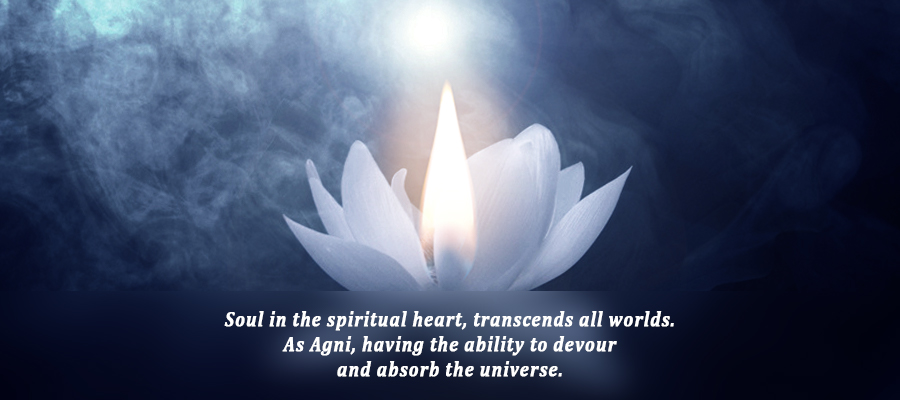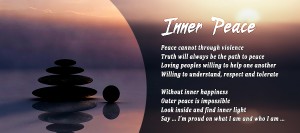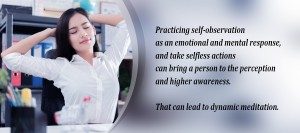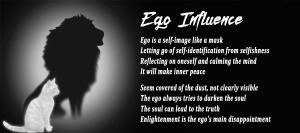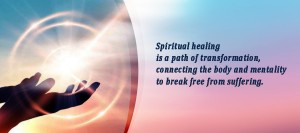Self-inquiry Practice
Self-inquiry can be done at all times, places and circumstances. It does not require knowledge of special yoga techniques. It does not require that we otherwise try to overtly change ourselves or what we are doing. It only requires that we place our attention on the source from which thought naturally springs. This, however, is one of the most difficult of all things because it requires control of the wavering and fickle mind. Yet there are several things that can help promote it.
Self-inquiry is done most easily when we are sitting alone, particularly in nature. The outer nature is the door to the inner nature. It provides the space and peace that allows the mind to return to its source. In nature, apart from our personal involvements, we can more easily inquire into who we really are, into not only the meaning of human life but that of cosmic existence.
We can practice Self-inquiry when we are around other people, but this requires more effort because social contact pulls the mind outward. It is important therefore to reduce our outer activities and social contacts to aid in Self-inquiry. Generally in India Self-inquiry is not done in a group setting, in a standardized manner or according to a specific course of practice. It is mainly done on an individual basis, though communion between practitioners is encouraged as is specific instruction from the teacher.
To practice Self-inquiry while we are engaged in action we can call to mind the inquiry “Who is the doer?” In this way we will not let our actions dominate our awareness. This in fact gives us better skill in action because it removes any ego distortions from what we are attempting to do.
Perhaps the easiest way to approach to Self-inquiry is to learn to discriminate between the seer and the seen. First, one discriminates the seer from objects in the external world, like looking at a the leaves of a tree blowing in the wind. One holds to the eye as the seer and what the eye sees as the seen, noting that fluctuations in external objects do not cause the eye to change. One’s power of seeing remains constant through the various objects seen.
Second, one discriminates the seer from the sense organs. In this instance the mind is the seer and the senses are the seen. There are several senses and each one varies in acuity but the seer of the senses is constant and not altered by their fluctuations. For example, the seer of the eye is not tarnished by any impairments in the eye, like loss of visual acuity.
Third, one discriminates between the seer and mental states. The self is the seer and the mind is the seen.Thoughts and feelings continually change but their seer, if we look deeply, remains the same. Our seeing as a child and as an adult is the same seeing, not only of external objects but of our internal thoughts and feelings.
Fourth, one discriminates between the seer and the ego, between the pure-I or higher Self and and the lower self, the I identified with body, emotion or thought. We learn to observe ourselves and our personal limitations, as external forms like our house or our car. We see the ego as various mental conditions but not the true Self that is beyond the mind. The pure Self devoid of external associations can then shine forth. One then strives to abide in that state of pure awareness.
An in this process is to negate external objects as not the Self or not I. Then one can negate internal thoughts and feelings, including the ego itself. Whatever one can perceive as an object externally or internally is not the Self who is the witness of all.
Assessing Practice
Even a beginner can benefit from the practice of Self-inquiry. It is not difficult to begin the process of Self-inquiry and experience a shift in our sense of self. Our thoughts begin to subside as we realize that what we have called our self is largely only an identification of the I with some thought or feeling that is external and transient. We see that the more our thoughts deviate from Self-awareness, the more confusion and suffering is created. Yet though this process is not difficult to initiate, it is difficult to sustain.
Most of us will discover that we can practice Self-inquiry for a time, perhaps extending through several months or years but that it is hard to maintain it as a primary or ongoing practice. It is not a practice like pranayama or mantra that can be done in a routine manner. There is no particular structure or ceremony to it. It is not a step by step process with different levels and angles that can be easily mapped out. It remains at the center but to get to the center and stay there is not that easy. While we make some headway with it, we often reach a barrier that is hard to cross. While it is easy to get rid of superficial identifications like those of a political or social nature, it is much more difficult to break our identification with our own body, emotions, and memories.
Self-inquiry is also a difficult practice to judge. Because it has no real stages one can wonder whether one is making any progress at all, or one can imagine great progress when there is none. The easiest way to determine one’s progress is detachment, peace and equanimity of mind. If one is going deeply into the practice one will experience a state of Samadhi in which one goes beyond body- and ego-consciousness, the ordinary mind gets dissolved and time and space disappear.
Yet false Samadhis can occur, which is why the guidance of a genuine teacher remains important. This, however, is not easy to find. True teachers of Self-inquiry are often reclusive and seldom take on many students, usually only those who are ready for intense practice. Those who make a big outer display of being teachers of this direct path and who gather large numbers of people around themselves are often those who failed to finish their practice, which is generally long and arduous.
People fail at Self-inquiry for two reasons: either we haven’t prepared the ground for it properly or we haven’t been consistent in our practice. In fact very few people who begin the practice of Self-inquiry continue with it as their primary practice and most eventually abandon it altogether. While an instant enlightenment path, becoming immediately the Self of all, is an appealing concept that can arouse a temporary enthusiasm, it usually requires lifetimes, not merely years of deep practice. Therefore it is best to approach Self-inquiry as a long term process, not seeking immediate results. One should first aim at a regular practice, for example, half an hour morning and evening, after other yogic or meditational practices to prepare the mind, and continue this for some time before judging the efficacy of what one is doing.
In the ultimate truth the Self is the reality and our inquiry into it and all else that we do is merely a fiction of thought. Yet this fiction of thought is not personal but includes the entire universe. It is the great Maya of the Lord (Bhagavan) that requires not only our own selfless effort but Divine grace in order to cross over it.

